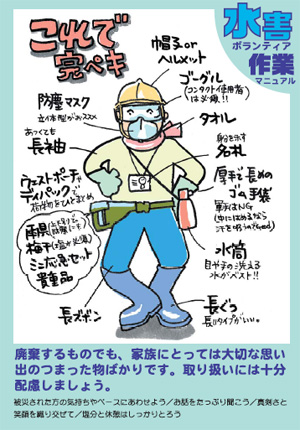
Got a call from Damian Penston this morning, who is concerned that many groups doing clean-up work in the affected areas may not be conscious of health risks associated with asbestos and other contaminants they are likely to be exposed to if working near destroyed buildings, etc.
This is a reminder that if you are volunteering in a disaster zone, it is imperative that you take responsibility for conducting your own thorough research on the health risks associated with the work you will be doing, assessing the dangers, and taking appropriate precautions.
That said, here are a few recommendations gathered from different sources.
1. If you are near broken buildings and there is any risk of asbestos dust, please wear a dusk mask with at least an N95 rating. HEPA filter masks are best. Here is an article that touches on the risks.
2. Depending on the conditions where you are working, there may be broken glass, exposed rusty nails, and other hazardous debris. Please consider obtaining boots with steel toes. It is also possible to purchase metal insoles to insert in the bottom of your boots to prevent puncture. If your boots are rubber rather than leather, remember that a nail can still puncture the side of the boot and watch where you step.
3. A tentanus shot booster is recommended. Even a small cut or wound can lead to tetanus.
4. Even if you are just clearing mud in fields and not working around a lot of debris, I recommend rubber or leather gloves over cotton ones. The dust goes right through cotton gloves and will desiccate and irritate your hands over time.
5. Other recommended items include helmets, goggles (especially if you wear contacts), long sleeve rain gear, towels (worn around the neck), whistles (for summoning help in an emergency), etc. This link (Japanese) illustrates guidelines for outfitting yourself. Once again, you must decided how much of this gear is appropriate to the conditions in the area where you are working.
http://www.rsy-nagoya.com/rsy/common/pdf/suigai-manual.pdf
6. When you finish working, it is always recommended that you wash up thoroughly and gargle.
Here is a link to one source of affordable safety gear (thanks, Sandi!):
5/23 - This just in from Damien:
http://www.maacenter.org/asbestos/abatement/diy-abatement.php
"It is also important to note that individuals with facial hair should not participate in asbestos removal, as protective gear may not fit properly and potentially expose them to loose particles."

I actually enjoyed reading through this posting. Many thanks.
ReplyDeleteSafety Work Boots